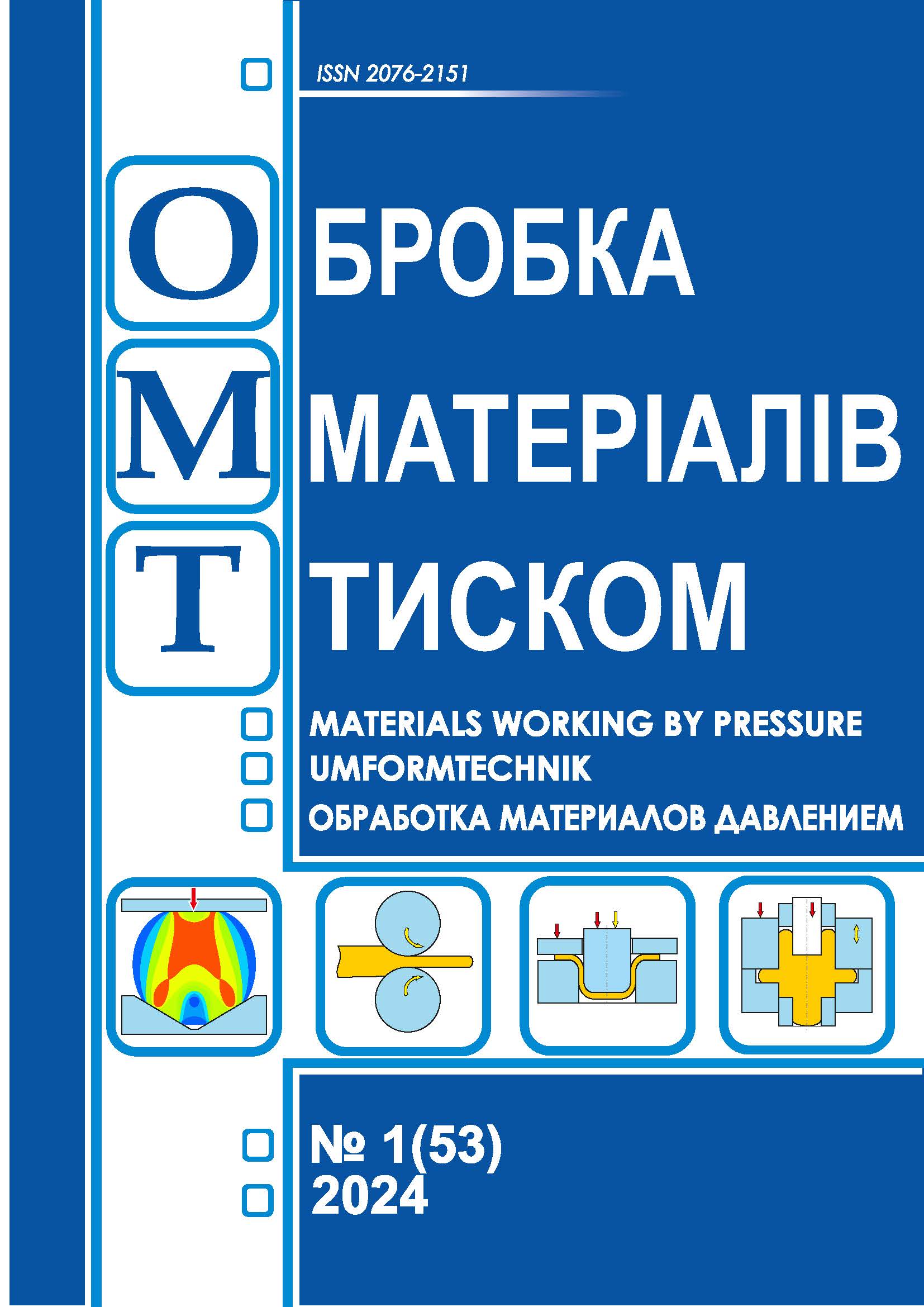Research of the method of rolling projectile from tubular workpiece
DOI:
https://doi.org/10.37142/2076-2151/2024-1(53)53Keywords:
deformation, pipe billet, rolling, heating, bottom, friction tool, FEM.Abstract
Markov O., Shevtsov S., Aldokhin M., Panov V., Rovenskyi S.
Research of the method of rolling projectile from tubular workpiece
The work is aimed at solving the current technical and scientific problem regarding the improvement of the technological processes of the production of blanks for parts such as artillery shells based on the application of the operation of tangential rolling with a friction tool, which makes it possible to manufacture hollow parts with a bottom. The finite element method was used to simulate the technological process of rolling the bottom with a friction tool, which made it possible to determine the rational shape and dimensions of the rolled pipe blanks and their preheating temperature. Recommendations have been developed for the design of energy-saving technological processes of rolling parts such as sleeves, which allow to set the wall thickness of the pipe billet before rolling, the heating temperature of hollow billets, as well as the amount of relative feed of the billet to the friction tool. The established recommendations were verified by experimental studies on steel blanks. According to the research results, it was established that the rolling of spherical bottoms should be implemented for pipe blanks with a relative wall thickness (D/s), which is in the range of 15...20. The homologous heating temperature of the hollow billet was 0.8, and the relative feed of the pipe billet into the friction tool was 0.9. Approbation of the determined ratios in laboratory conditions proved that there are established recommendations for changing the shape and size of spherical bottoms in the process of tangential rolling with a friction tool. The laws of shape change of the workpiece revealed in the work expanded the technological possibilities of the process of tangential rolling of bottoms and made it possible to establish the possibilities of the researched process. The results of macrostructural studies on steel products confirmed the results of finite element modeling on the effect of tangential rolling of the spherical bottom on support in the axial zone. Based on the results of research, it was established that this method can be used for products that have a bottom with an axial hole (artillery shells, hydraulic cylinders, etc.). Axial defects in this case will be removed when drilling an axial hole.
References
Markov O., Gerasimenko O., Aliieva L., Shapoval A., Kosilov M. Development of a new process for ex-panding stepped tapered rings (2019). Eastern-European Journal of Enterprise Technologies, 2 (1-98), pp. 39-46. DOI: 10.15587/1729-4061.2019.160395 http://doi.org/10.15587/1729-4061.2019.160395
Markov O., Gerasimenko O., Khvashchynskyi A., Zhytnikov R., Puzyr R. Modeling the techological pro-cess of pipe forging without a mandrel (2019). Eastern-European Journal of Enterprise Technologies, 3 (1-99), pp. 42-48. DOI: 10.15587/1729-4061.2019.167077 http://doi.org/10.15587/1729-4061.2019.167077
Hrudkina N., Aliieva L., Abhari P., Markov O., Sukhovirska L. Investigating the process of shrinkage de-pression formation at the combined radialbackward extrusion of parts with a flange (2019). Eastern-European Journal of Enterprise Technologies, 5 (1-101), pp. 49-57. DOI: https://doi.org/10.15587/1729-4061.2019.179232 https://doi.org/10.15587/1729-4061.2019.179232
Markov O., Panov V., Karnaukh S., Khvashchynskyi A., Zhytnikov R., Kukhar V., Kosilov M., Rizak P. Determining the deformed state in the process of rolling conical shells with a flange (2020). Eastern-European Jour-nal of Enterprise Technologies, 6 (1-108), pp. 34-41. DOI: https://doi.org/10.15587/1729-4061.2020.216523
Hrudkina N., Aliiev I., Markov O., Savchenko I., Sukhovirska L., Tahan L. Designing a kinematic module with rounding to model the processes of combined radial-longitudinal extrusion involving a tool whose configuration is complex (2021). Eastern-European Journal of Enterprise Technologies, 2 (1-110), pp. 81-89. DOI: https://doi.org/10.15587/1729-4061.2021.227120
Wu Y., Dong X., Yu Q. Upper bound analysis of axial metal flow inhomogeneity in radial forging pro-cess. International Journal of Mechanical Sciences. 93 (2015). pp. 102–110.
Sizek H. W. Radial Forging. Metalworking : Bulk Forming 2005. pp. 172–178.
Markov O., Kosilov M., Panov V., Kukhar V., Karnaukh S., Ragulina N., Bochanov P., Rizak P. Modeling and improvement of saddling a stepped hollow workpiece with a profiled tool (2019). Eastern-European Journal of Enterprise Technologies, 6 (1-102), pp. 19-25. DOI: https://doi.org/10.15587/1729-4061.2019.183663
Ghaei А., Movahhedy M. R., Taheri A. Karimi. Finite element modelling simulation of radial forging of tubes without mandrel. Materials & Design. 2008. № 29. pp. 867–872.
Fan L., Wang Z., Wang H. 3D finite element modeling and analysis of radial forging processes. Journal of Manufacturing Processes. 16 (2014). pp. 329–334.
Allieva L., Hrudkina N., Aliiev I., Zhbankov I., Markov O. Effect of the tool geometry on the force mode of the combined radial-direct extrusion with compression (2020). Eastern-European Journal of Enterprise Technolo-gies, 2 (1-104), pp. 15-22. DOI: https://doi.org/10.15587/1729-4061.2020.198433
Burkin S. P., Korshunov E. A., Kolmogorov V. L., Babailov N. A., Nalesnik V. M. A vertical automated forging center for the plastic deformation of continuously-cast ingots. Journal of Materials Processing Technology. 1996, 58. pp. 170–173.
Sanjari. М., Saidi P., Karimi Taheri A., Hossein-Zadeh M. Determination of strain field and heterogeneity in radial forging of tube using finite element method and microhardness test. Materials and Design. 38 (2012). pp. 147–153.
Markov O., Khvashchynskyi A., Musorin A., Lysenko, A. FEM study of the drawing method of hollow forgings with a bottom without a mandrel. Materials Working by Pressure. 2023. 1(52), pp. 3-9. DOI: https://doi.org/10.37142/2076-2151/2023-1(52)3 (in Ukrainian).
Markov O., Stankov V., Panov V., Zinskyi V. Study of deformation method of hollow workpieces with bottom by dies with chamfer. Materials Working by Pressure. 2023. (1(52), pp. 71-78. DOI: https://doi.org/10.37142/2076-2151/2023-1(52)71 (in Ukrainian).
Markov O., Molodetskyi V., Zinskyi V., Abhari P. Experimental study of a new process of deformation of forgings such as sleeves. Materials Working by Pressure. 2023. (1(52), pp. 79-85. DOI: https://doi.org/10.37142/2076-2151/2023-1(52)79 (in Ukrainian).

